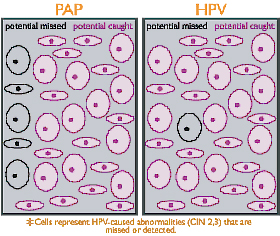|


The HPV DNA Test
- It is now known that cervical cancer is caused by the human papillomavirus (HPV)
- In a Pap test, a laboratory technician visually examines a sample of cervical cells under a microscope to look for abnormal changes caused by HPV. In a "conventional" Pap test, the doctor or nurse collects the cell sample during a pelvic exam, then places a "smear" of cells directly onto the slide sent to the lab. In a "liquid-based" Pap, those cells are suspended in a liquid before being placed on the slide, which makes abnormalities easier to detect. All types of Pap smears, however, are subject to human error and interpretation.
- The HPV DNA test (also called "The HPV Test" or the "DNA with Pap") uses advanced, molecular technology to determine whether any one of the HPV virus types that cause cervical cancer is present in the cervical cells. It works by detecting the genetic or DNA "footprint" of the virus. There is no need for a judgment call, and thus virtually no risk of error.

|
Looks For: |
How it Works |
Pap Test |
Signs of abnormal cell changes |
Lab professional looks at a sample of cervical cells through a microscope |
HPV Test |
The virus that causes the abnormal cell changes that can lead to cervical cancer |
A test is done on the sample of cervical cells by an automated system |
- Clinically, the HPV test is done at the same time as the Pap. Your healthcare provider simply asks the lab to run both tests - either on the same sample of cells (in the case of a liquid-based Pap) or on a separate sample (if a conventional Pap was used). Women don't need to do anything different except to ask for the HPV test.
- By combining the HPV and Pap tests, the ability to identify women at risk for cervical cancer is increased to virtually 100 percent.

- Use of HPV testing for routine screening is recognized in guidelines issued by the American College of Obstetricians and Gynecologists and the American Cancer Society.
- The majority of insurance companies cover the HPV test for routine screening for women over 30.
- • There is only one FDA-approved HPV test that detects the cancer-causing types of the virus: The Digene® HPV Test. It is approved for use in conjunction with a Pap test for women age 30 and older, the group most at risk of developing cervical cancer, as well as for follow-up evaluation of women of all ages whose Pap results are inconclusive. For more information, visit www.theHPVtest.com.

Created: 7/28/2006 - Donnica Moore, M.D.
|
 All the content contained herein is copyrighted pursuant to federal law. Duplication or use without
the express written permission of DrDonnica.com subjects the violator to both civil & criminal penalties.
Copyright © 2006 DrDonnica.com. All rights reserved. |
 |
Home
| Today on DrDonnica.com
| Meet Dr. Donnica
| TV Appearances
| Clinical Trials
Diseases & Conditions
| Decisionnaires
| Celebrity Speak Out
| Guest Experts
| Women's Health Champions
FAQs
| Women’s Health Resources
| Archive
| Books & Tapes
| Site Certification
| Advanced Search
Mission
| What’s New?
| Press Room
| Privacy Policy
| Sponsors
| Partners
| Contact Us
|
|



